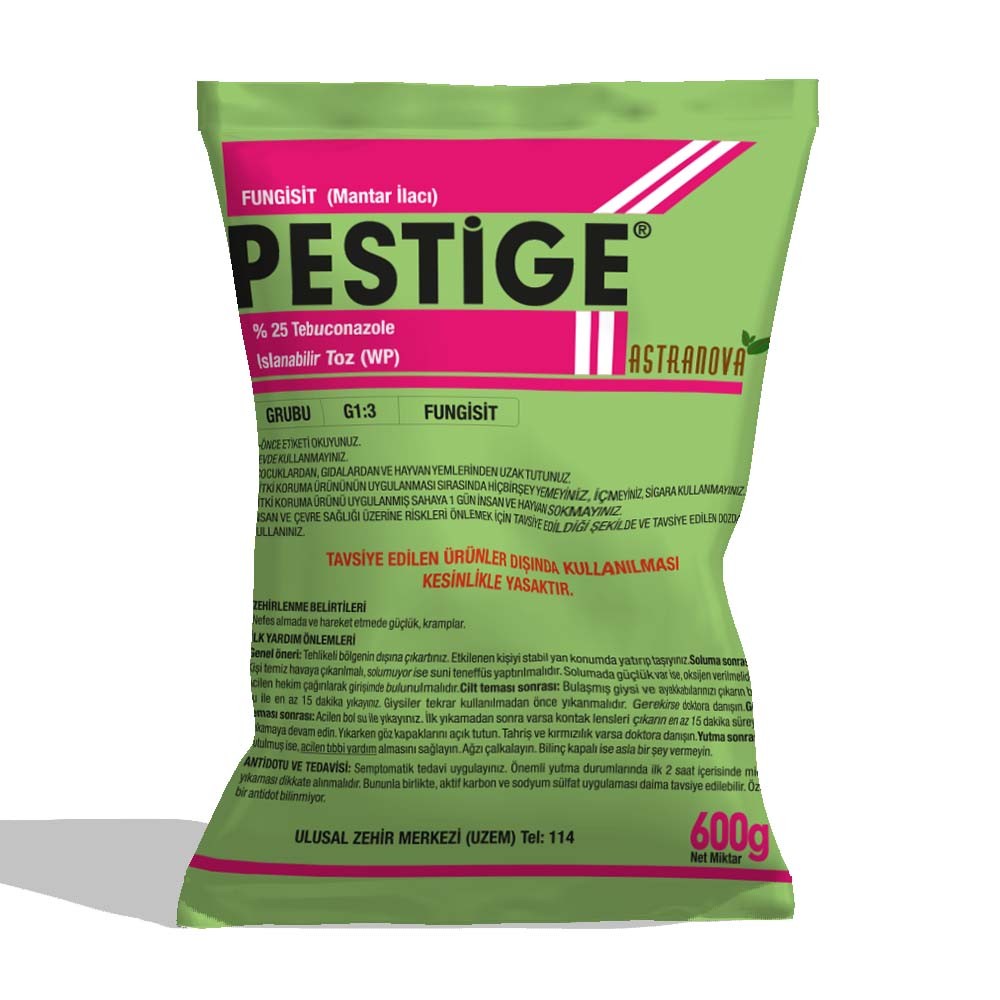PESTİGE

Active Ingredient: % 25 Tebuconazole
Formulation: WETTABLE POWDER (WP)
Packing: 100 g, 200 g, 250 g, 400 g, 600 g, 800 g, 1 kg, 5 kg
Use plant protection products with care.
Be sure to read the label and product information before use.
Label Information Safety Data Sheet Product BrochurePLANT AND HARMFUL ORGANISIMS TO BE USED
|
Plant Name |
Harmful Organism Name |
Usage Dose |
Time Between Final Application and Harvest |
|
tomato
|
Early Leaf Blight (Alternaria solani) |
50 g/100 L on |
7 days |
|
apple
|
Black stain (Venturia ineaqualis) |
25 g/100 L on |
14 days |
|
Appearance (Podosphaera leucotricha) |
25 g/100 L on |
14 days |
|
|
poverty |
Black stain (Pirina Venturia) |
25 g/100 L on |
14 days |
|
KAYISI |
Sing in hard-core fruits (Sclerotinia laxa) |
60 g/100 L on |
14 days |
|
wheat
|
Yellow rust (Puccinia striiformis) |
75 g/da |
35 days |
|
Septoria Leaf Stain (Septoria tritici) |
75 g/da |
HOW TO USE THE PLANT PROTECTION PRODUCT
Early Leaf Blight in Tomatoes:
Application should be started both in seedlings and in the field as soon as the first spots are seen. When climatic conditions are suitable for disease development, spraying is continued at intervals of 10-14 days according to the course of the disease and climatic conditions.
Apple Powdery mildew: Application 1: Pink flower bud period
Application 2: When 60-70% of flower petals are shed
3. and other applications: As long as the appropriate conditions for the disease continue, the applications are continued with an interval of 10 days, taking into account the duration of action of the plant protection product used.
Apple carale: Application 1: When the flower eyes swell (3-5 days ago in places with branch rows)
2. Application: During the pink rosette bud period (when the flowers are seen separately)
3. Application: When flower petals are shed 70-80%
4. and other applications should be carried out 15 days apart when climatic conditions are suitable for the progression of the disease.
Pear Carale: 1.Application: When the flower eyes arepuffed up (3-5 days ago in places with branch rows)
2.Application: During the white badge period,
3.Application: When 70-80%of the flower petals fall,
4. and other applications should be carried out 10 days apart when climatic conditions are suitable for the progression of the disease.
Flowermonium in hard-core fruits (Apricot):
1.Practicelllama:At the beginning of the pull (in 5-10% flowers)
2.Application: Tam is done inflowering (90-100% flower).
Wheat Yellow Rust: Applications should be startedwhen the symptoms of the disease are shown. Green parts are applied against rust factors. The surface of the leaves and stem should be applied so that it is covered with medicated water. Taking into account the climatic conditions and the condition of the disease, applications are continued at intervals of 10-14 days when necessary.
Septoria leaf stain in wheat: If climatic conditions are suitable for the development of the disease and there is a possibility of an epidemic condition, green parts are applied. In general, the best time for application is before the end of the scabbard period or before the exit of the spike, when the flag leaf is fully opened. For an infection that climbs towards the upper parts of the plant in the early period, the flag leaf should not be expected to appear. Likewise, if the field is dishwashing and rainy weather continues during the period of spikes, implementation may be needed as there may be economic damage.
INFORMATION ABOUT THE STUDENT
Pestige, a plant protection product, is group G1 according to the mechanism of action; It is a fungicide classified as 3. Repetitive applications of plant protection products with the same mechanism of action promote the development of resistance. Therefore, in order to delay the development of resistance, do not exceed the total number of applications recommended during the same production season of PESTİGE. In cases where the application needs to be repeated, it has a different mechanism of action (GroupG1; 3 external) use of plant protection products.